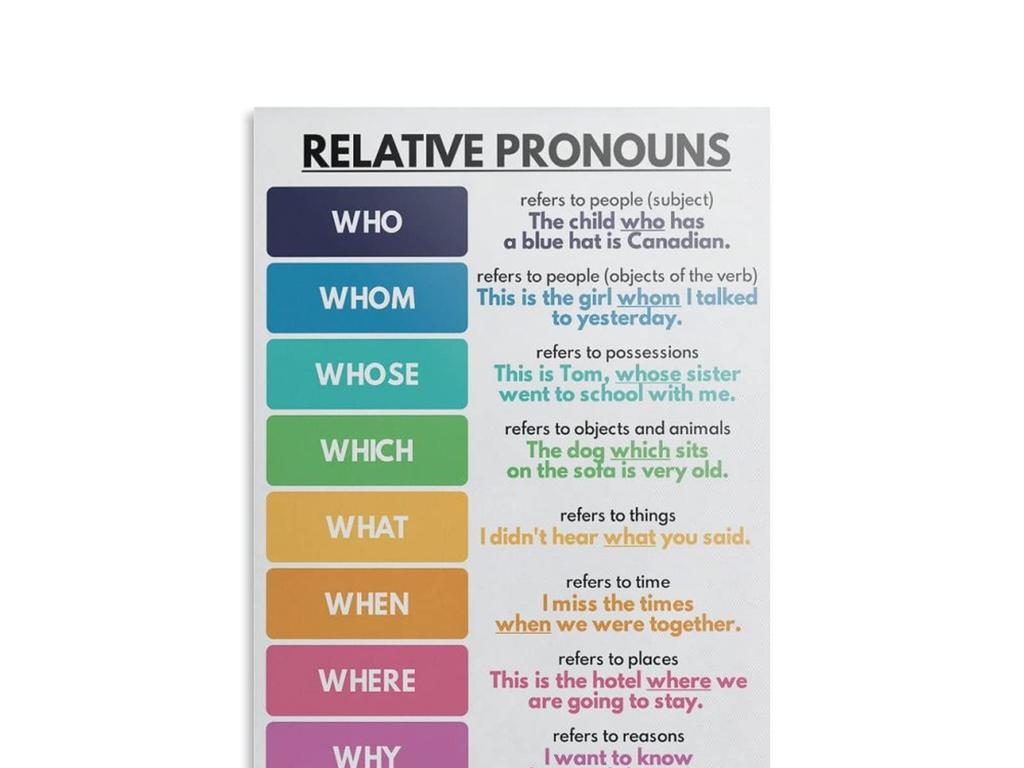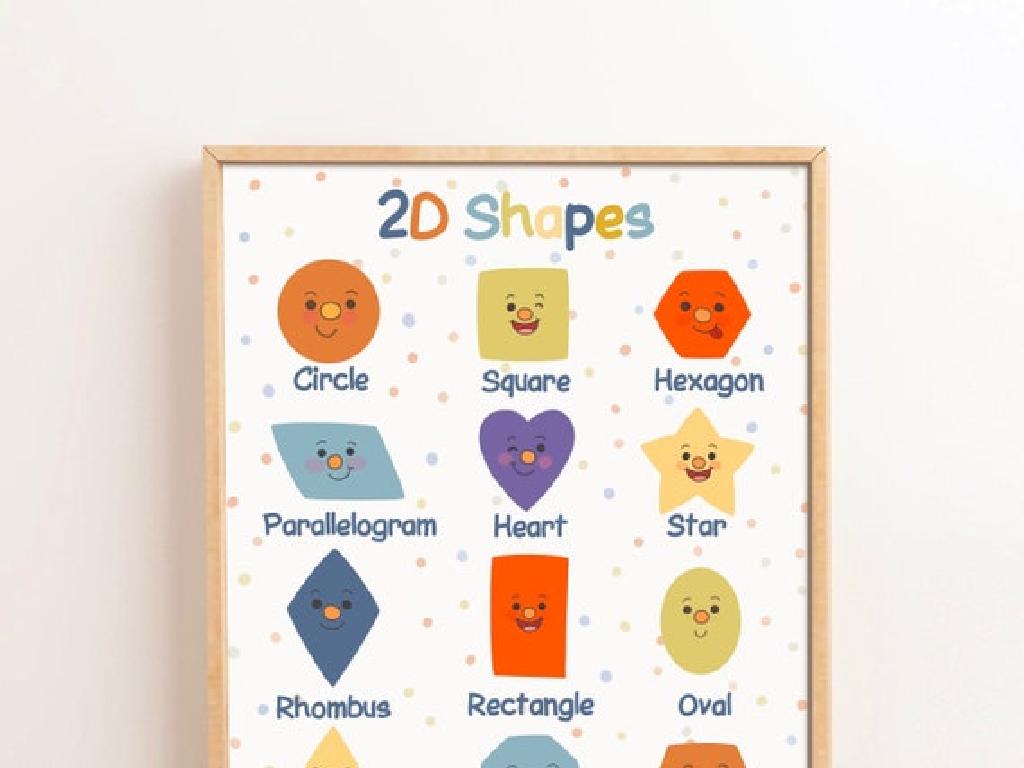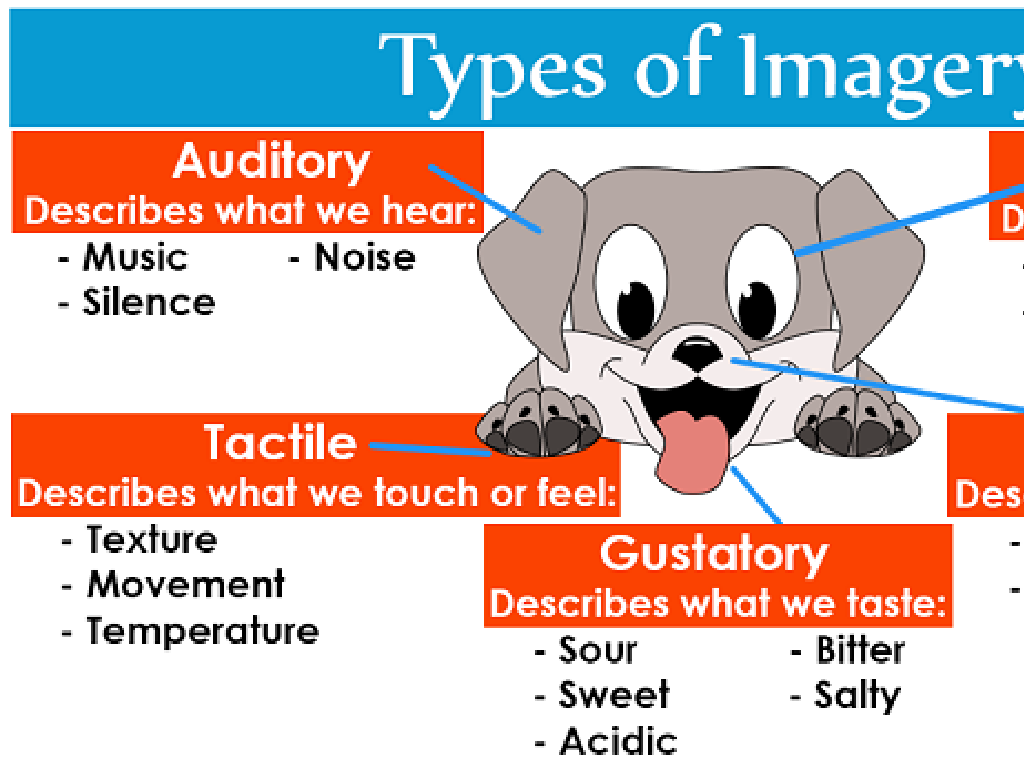Animal Adaptations: Feet And Limbs
Subject: Science
Grade: Fourth grade
Topic: Adaptations
Please LOG IN to download the presentation. Access is available to registered users only.
View More Content
Understanding Animal Adaptations: Feet and Limbs
– Animals adapt to survive
– Different habitats need different limbs
– Ducks have webbed feet for swimming, monkeys have hands for climbing
– Feet & limbs for climbing, running, swimming
– Cheetahs have light, slim limbs for speed; Frogs have webbed feet for leaping and swimming
– Discuss: Why varied animal feet?
Think about how different feet help animals in their homes
|
This slide introduces the concept of animal adaptations, specifically focusing on feet and limbs. It’s crucial to explain that adaptations are special features that allow animals to survive in their unique environments. Discuss various habitats and how they influence the development of specialized limbs, such as webbed feet for swimming or strong legs for jumping. Encourage students to think critically about why animals have evolved with different types of feet and limbs by considering the functions these adaptations serve. Use interactive questioning to engage the students and help them connect the concept of adaptation to the diversity of animal life.
Exploring Animal Adaptations: Feet and Limbs
– What are adaptations?
– Special features for survival in habitats
– Types: Structures and behaviors
– Body parts like beaks, or actions like migration
– Examples: Feet and limbs
– Ducks have webbed feet for swimming, monkeys have long limbs for climbing
– Think of animals you know
|
Adaptations are crucial for the survival of animals in their natural habitats. They include physical structures such as feet and limbs, which can be specialized for different activities like swimming, climbing, or running. Behavioral adaptations, such as migration or hibernation, also play a significant role. Encourage students to think of animals they are familiar with and discuss the various adaptations these animals have. Ask them to consider how these adaptations help the animals survive in their environments. This will help students understand the concept of natural selection and the importance of adaptations in the animal kingdom.
Animal Adaptations: Feet and Limbs
– Diversity in feet and limbs
– Webbed feet aid in swimming
– Ducks and frogs have webbed feet to move in water
– Claws are great for digging
– Animals like moles use claws to dig tunnels
– Padded feet for stealthy movement
– Cats have padded feet to walk silently and hunt
|
This slide introduces students to the concept that different animals have specialized feet and limbs adapted to their environments and lifestyles. Emphasize the importance of these adaptations in helping animals survive by providing specific examples. Webbed feet, like those of ducks and frogs, help in swimming. Claws, seen in moles, are essential for digging. Padded feet allow cats to move quietly, aiding in their hunting. Encourage students to think of other animals and how their feet and limbs help them in their daily lives. This will help students understand the relationship between an animal’s physical characteristics and its habitat and behaviors.
Adaptations for Climbing
– Monkeys’ flexible climbing limbs
– Limbs bend easily, allowing for agile movement up trees
– Strong hands for grasping
– Fingers can wrap around branches securely
– Tails for balance and support
– Tails act like an extra limb for stability
– Climbing adaptation benefits
– These adaptations help monkeys find food and escape predators
|
This slide focuses on the specific adaptations monkeys have developed for climbing. Discuss how the flexibility of their limbs contributes to their agility, making it easier for them to navigate through trees. Highlight the importance of strong hands that can grasp branches firmly, which is crucial for climbing and foraging. Explain how their tails, often prehensile, serve as balancing tools or even as an additional limb to hold onto branches. Emphasize that these adaptations are essential for survival, aiding in food gathering and predator avoidance. Encourage students to think about how these adaptations compare to other animals and to humans, fostering a deeper understanding of evolutionary traits.
Adaptations for Running: The Cheetah
– Cheetahs’ legs are long and muscular
– Designed for sprinting quickly
– A flexible spine for longer strides
– Helps in taking big steps to run faster
– Semi-retractable claws for grip
– Provide traction during sprints
– Adaptations combine for high speed
|
This slide focuses on the cheetah, a prime example of animal adaptations for running. Cheetahs have evolved long, muscular legs that allow them to reach incredible speeds, making them the fastest land animals. Their flexible spine acts like a spring, enabling them to take long strides and increase their speed. The semi-retractable claws, unlike those of other big cats, provide them with extra grip during high-speed chases, preventing slipping. These adaptations work together to make the cheetah an exceptional runner, perfectly adapted for chasing down prey in the wild. Encourage students to think about how these adaptations help cheetahs survive and compare them to other animals they know.
Adaptations for Swimming
– Ducks’ webbed feet function
– Webbed feet help ducks paddle through water smoothly.
– Feet position aids swimming
– Ducks’ legs are towards the back, helping them push off in water.
– Webbed feet: Natural paddles
– Leg position: Propulsion boost
|
This slide focuses on how certain adaptations, like webbed feet and the positioning of legs, enable ducks to swim efficiently. Webbed feet act as natural paddles, creating a larger surface area to push against the water. The placement of their legs towards the rear end of their bodies provides better propulsion, making them excellent swimmers. Discuss with students other animals that have similar adaptations for swimming and encourage them to think about how these adaptations might have evolved. A possible activity could involve comparing the swimming abilities of different animals and linking those abilities to their physical adaptations.
Adaptations for Digging: Moles
– Moles’ spade-like paws
– Wide paws help moles dig efficiently.
– Short, powerful limbs
– Their limbs provide strength for tunneling.
– Designed for underground movement
– Moles are adapted to live and move beneath the surface.
|
This slide focuses on the specialized adaptations of moles for digging. Their wide, spade-like paws are perfect for moving soil, while their short and powerful limbs give them the strength needed to tunnel through the ground. These physical adaptations allow moles to thrive in an underground habitat. Discuss with students how these adaptations help moles survive and how they compare to other animals with different adaptations for living in their environments. Encourage students to think of other animals that dig and what features they might have to help them.
The Importance of Animal Adaptations
– Adaptations for survival
– Animals develop features to live and thrive in their habitats.
– Adaptations for daily needs
– Finding food, self-defense, and nurturing young are aided by specific adaptations.
– Evolution of adaptations
– Adaptations develop over generations to best fit the environment.
– Adaptations are essential
|
This slide aims to explain why adaptations are crucial for animals. Adaptations are specialized features that allow animals to survive and flourish in their unique environments. They are the result of a long process of evolution, where the most beneficial traits are passed down through generations. These adaptations can be for finding food, such as sharp claws for hunting, or for protection, like camouflage. They also include ways to care for offspring, ensuring the survival of the species. Discuss examples like the webbed feet of ducks for swimming or the long legs of a kangaroo for jumping. Encourage students to think about how different adaptations help animals in various environments.
Class Activity: Design Your Own Creature
– Be a creature creator!
– Choose a habitat for your creature
– Is it a jungle, desert, ocean, or arctic?
– Consider the habitat’s challenges
– Think about temperature, water, and predators
– Adapt your creature’s limbs for survival
– Long legs for running or webbed feet for swimming?
|
This activity encourages students to apply their knowledge of animal adaptations to design a creature suited for a specific habitat. Provide examples of different habitats and the unique challenges animals face in each. Discuss how adaptations like the size, shape, and function of feet and limbs help animals survive. For instance, webbed feet for swimming in water or thick fur for warmth in the arctic. Split the class into small groups and let each group pick a different habitat. Provide drawing materials and let their imaginations run wild as they create and then present their creatures to the class. Possible activities: drawing their creature, explaining their adaptations, comparing with real animals, or even creating a short story about a day in the life of their creature.
Share Your Creations: Adaptation Wonders
– Present your unique creature
– Explain its survival adaptations
– How do the feet and limbs help in its environment?
– Compare with real animal adaptations
– Use examples from class like ducks or monkeys
– Engage in class discussion
|
This slide is for a class activity where students will present the creatures they’ve created, focusing on the adaptations of feet and limbs that help the creatures survive in their imagined environments. Encourage students to explain how their creature’s adaptations would work in real life and to make connections with the animals studied in class, such as the webbed feet of ducks for swimming or the strong limbs of monkeys for climbing. The discussion should highlight the diversity of adaptations in the animal kingdom and reinforce the concept that adaptations are crucial for survival. Provide a supportive atmosphere for students to share their ideas and ensure that each student has the opportunity to present and receive feedback.
Conclusion: The Role of Adaptations
– Recap of adaptation types
– Adaptations’ role in survival
– Adaptations help animals survive in their environments.
– Think of unique animal adaptations
– Examples: webbed feet for swimming, long legs for running.
– Discuss why adaptations matter
– Adaptations can lead to success in hunting, escaping predators, and more.
|
As we conclude today’s lesson on animal adaptations, particularly focusing on feet and limbs, let’s revisit the key points we’ve covered. Start by summarizing the different types of adaptations we’ve learned, such as webbed feet for aquatic animals or sharp claws for climbing. Emphasize the importance of these adaptations in helping animals survive, find food, and protect themselves. Encourage students to think of other animals they know and the unique adaptations they have. This discussion will help solidify their understanding of the concept of adaptations and their significance in the animal kingdom. Ask students to share their thoughts and provide examples to ensure they can apply what they’ve learned.





